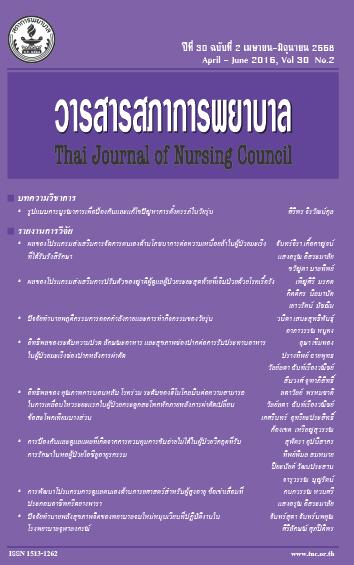ปัจจัยทำนายพฤติกรรมการออกกำลังกายและการทำกิจกรรมของวัยรุ่น
Keywords:
พฤติกรรมการออกกำลังกายและการทำกิจกรรม การรับรู้สมรรถนะตนเอง ภาวะเมตาบอลิคซินโดรม วัยรุ่น, exercise and activity behaviour, performance awareness, metabolic syndrome condition, teenagerAbstract
บทคัดย่อ: วัตถุประสงค์: เพื่อศึกษาอานาจการทานายของความรู้เกี่ยวกับภาวะเมตาบอลิคซินโดรม การรับรู้ประโยชน์ การรับรู้อุปสรรค และการรับรู้สมรรถนะตนเอง ต่อพฤติกรรมการออกกำลังกายและการทำกิจกรรมของวัยรุ่น
รูปแบบการวิจัย: การวิจัยเชิงทำนายความสัมพันธ์
วิธีดาเนินการวิจัย: กลุ่มตัวอย่าง คือนักเรียนชั้นมัธยมศึกษาปีที่ 4 โรงเรียนรัฐบาล กรุงเทพมหานคร จานวน 227 ราย เก็บรวบรวมข้อมูลโดยใช้แบบสอบถามเกี่ยวกับความรู้ ประโยชน์ อุปสรรค สมรรถนะตนเอง และพฤติกรรมการออกกาลังกายและการทากิจกรรม วิเคราะห์ข้อมูลโดยใช้สถิติพรรณนา ค่าสัมประสิทธิ์สหสัมพันธ์ของเพียร์สัน และการวิเคราะห์ความถดถอยแบบพหุคุณ
ผลการวิจัย: ปัจจัยที่สามารถทานายพฤติกรรมการออกกาลังกายและการทากิจกรรมของนักเรียนคือ การรับรู้สมรรถนะตนเอง (b = 0.32, p < .01) และการรับรู้อุปสรรค (b = -0.17, p < .05) โดยพบว่า การรับรู้สมรรถนะตนเองมีอิทธิพลสูงสุด (β = 0.37) ส่วนการรับรู้อุปสรรคมีอิทธิพลน้อยกว่า (β = -0.17) และปัจจัยทั้งหมดสามารถร่วมกันทำนายความแปรปรวนของพฤติกรรมการออกกำลังกายและการทำกิจกรรมของนักเรียนได้ร้อยละ 26 (R2 = .26, p < .01)
ข้อเสนอแนะ: บุคลากรสุขภาพ ครู ผู้บริหารโรงเรียน และผู้ปกครองควรมีส่วนร่วมในการจัดกิจกรรมส่งเสริมสมรรถนะตนเองของนักเรียน หาแนวทางในการลดอุปสรรคต่างๆ ในการออกกาลังกายและการทำกิจกรรมของนักเรียนทั้งในที่โรงเรียนและที่บ้าน
Abstract:Objective: To study metabolic syndrome knowledge, benefit awareness, obstacle awareness and performance awareness, and their power to predict teenagers’ exercise and activity behaviour.
Design: Correlation-predicting research.
Implementation: The subjects were 227 Mathayom 4 (tenth-grade) students at a public school in Bangkok. A questionnaire was used to collect the following data: metabolic syndrome knowledge, benefits, obstacles, performance and exercise and activity behaviour. The data were analysed using descriptive statistics, Pearson’s correlation coefficient and multiple regression analysis.
Results: The factors found capable of predicting the teenage participants’ exercise and activity behaviour were performance awareness (b = 0.32, p < .01) and obstacle awareness (b = -0.17, p < .05). Performance awareness was identified as the most influential factor (β = 0.37), and obstacle awareness as a less influential one (β = -0.17). All of the factors combined were capable of predicting exercise and activity behaviour variations in 26 percent of the participants (R2 = .26, p < .01).
Recommendations: It is recommended that healthcare personnel, teachers, school administrators and parents be engaged in preparing activities that promote students’ performance and in seeking approaches to reducing exercise and activity obstacles, both at school and at home.
คำสำคัญ: พฤติกรรมการออกกำลังกายและการทำกิจกรรม การรับรู้สมรรถนะตนเอง ภาวะเมตาบอลิคซินโดรม วัยรุ่น: exercise and activity behaviour; performance awareness; metabolic syndrome condition; teenager mso-bidi-font-family:"Times New Roman"; mso-bidi-theme-font:minor-bidi;}
คำสำคัญ: พฤติกรรมการออกกำลังกายและการทำกิจกรรม การรับรู้สมรรถนะตนเอง ภาวะเมตาบอลิคซินโดรม วัยรุ่น: exercise and activity behaviour; performance awareness; metabolic syndrome condition; teenager mso-bidi-font-family:"Times New Roman"; mso-bidi-theme-font:minor-bidi;}
คำสำคัญ: พฤติกรรมการออกกำลังกายและการทำกิจกรรม การรับรู้สมรรถนะตนเอง ภาวะเมตาบอลิคซินโดรม วัยรุ่น : exercise and activity behaviour; performance awareness; metabolic syndrome condition; teenager








